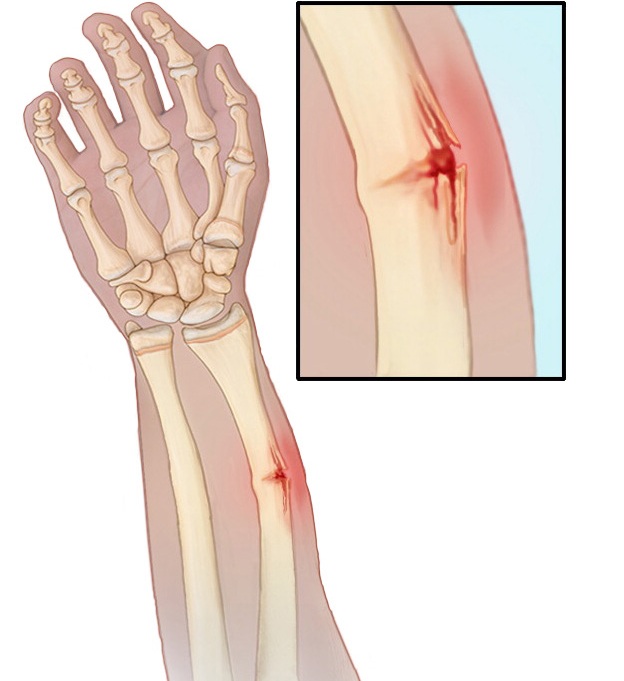A type of fracture that affects the side of a bone, due to which the side of the bone bend outward without fully break, is known as buckle fracture. Sometimes also referred as a torus fracture. Buckle fracture is often compared to a greenstick fracture. Greenstick fracture is also a type in which one side of the bone bends outward but the only difference between two is the complete breakage of bone at the other side in later one.
Buckle fracture is commonly seen in children, especially during the phase when their bones are still growing and their bones are still soft unlike adults who bones are harder. In addition to children, the buckle fracture is one that is also found in most elderly people after falling, especially involving the radius and ulna bones in their forearms and the bone in their wrist. It is common in these areas because the bones are fragile. The word “torus” comes from the Latin word “tori” which means swelling. Normally healing period is about a month.
Fracture are of many types like complete fracture in which a complete breakage of the bones occurs. The breaks of the bones are often in straight lines. Another kind of fracture is comminuted fracture, when the bones are broken up into smaller pieces and usually the fragments of the bones are unaligned. In compression fracture, also called as impacted fractures where the breakage of the bones is mostly secondary to the disease process. Another type of fracture is compound fracture, in which the bone that is broken is exposed to the skin. Due to its nature, it is also called as open fracture and the risks of infection are higher because bacteria, viruses and others can enter the punctured skin.

Buckle/Torus Fracture on Wrist/Arm
Below you will find all information about buckle fracture on Wrist or Arm such as symptoms, causes, diagnoses and treatment.
Symptoms
Following are some symptoms that are very common in this situation like:
- while moving the affected area, patient have an uncomfortable feeling
- Pain
- Swelling
Causes
such medical condition have always something behind them. In buckle fracture case, it depends on the area where you got it, so cause of fracture can vary greatly.
Approximately fifty percent of fractures that children and the elderly have are Radius and ulna fracture. These are the two bones found in your forearms. The reason behind is the carefree behavior of children and seem to fall a lot as they run, play, and jump with their arms outstretched.
Wrist is another common area where mostly children get fracture. May you have seen that when a child falls, mostly he used to extend hands for support so they can try to catch themselves. This type of buckle fracture is also very common and accounts for approximately thirty percent all fractures that occur in children and the elderly.
Another area where fracture can occur but not often and also not considered as serious buckle fracture is figure. It prevents the range of motions in that finger, especially the fine motor movements.
Diagnosis
X-ray is the most common way to diagnosis a buckle fracture. Doctor can determine only with the help of x-ray, if it is a buckle fracture or not, and how severe it is. In case of any ambiguity, doctor may also recommend a CT scan or MRI done.
Treatment
Common way of treating buckle fractures are by splinting or casting them. In order to treat such a medical condition, you have to visit orthopedic physician and get treatment advise. Orthopedic physician has specialization in treating different bone problems, including fractures. The bones have tendency to naturally heal by themselves but to keep the area immobilized and prevent further damage, splinting or casting is important. Following are three main steps while treating buckle fractures:
- Fractured bone brings pain and very uncomfortable feeling especially with children and the elderly.So as a first step, your orthopedic physician will usually prescribe over-the-counter non-steroidal anti-inflammatory (NASIDs) like ibuprofen and acetaminophen to help with the pain.
- As a second step of treatment and an important part of healing, immobilization is recommended. Casting or splinting will make sure that the bone is aligned properly so it will heal correctly. It also helps to reduce the swelling and in turn reduce the pain.
- Although in buckle fracture, surgery is not necessary because it can be corrected by immobilization techniques. But in more severe cases, surgical interventions can be an option by the orthopedic surgeon if other conservative treatment does not apply to the patient.
- There are different surgeries that can be recommended such as the closed reduction external fixation (CREF) or the closed reduction internal fixation (ORIF). Post surgery complications like nerve injuries, pulmonary embolism, deep vein thrombosis are common.
 Health & Care Information
Health & Care Information 

